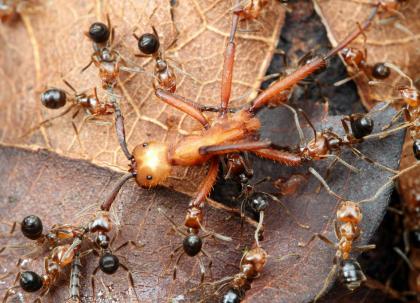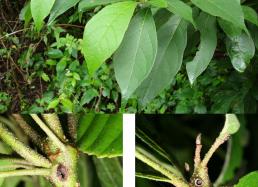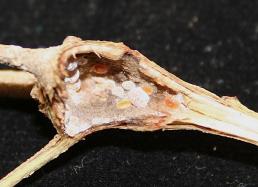Bog #8: Azteca & Turtle Ants
One great thing about the visit of Corrie and her team to the ACG has been the fun, ant-focused company it has provided. The other has been that I’ve started to think a lot about plant-derived ant diets, and the work of Corrie and her colleagues has encouraged me to consider the possible role of ant-gut microbial communities in ant nutrition. So I’ve eagerly brainstormed with them about these ideas to see if we can identify some interesting ways to proceed in my research system.
Since 2007, I've been working on a single species of tree, known as the Ecuador laurel or by its scientific name Cordia alliodora, that associates with ants throughout the New World tropics (Mexico to Argentina). These trees, much like the acacias that Corrie's team is working on, have evolved specifically to host nesting ants.
In the case of Cordia, the ants live inside cavities in the tree's stems (Photo #1 below). In return for nesting space, the ants defend the tree's leaves against leaf-eating insects. Because ants get nesting space and trees get defense, the interaction is mutually beneficial, so ecologists call it a "mutualism."
The Cordia ant system is particularly interesting to me for two reasons. First, it’s found in tropical forests from Mexico to Argentina, about 4,000 miles or more as the crow flies—so there’s tremendous potential for investigating how variation in the surrounding environment affects the interaction between trees and ants.
Second, what seems at first to be a two-way interaction between trees and ants turns out, on closer examination, to be a three-way interaction: the ants rear sap-feeding scale insects inside tree stem cavities (Photo #2 below), then these scale insects suck tree sap and excrete sugar-rich "honeydew" for the ants to eat. (Consider it a form of husbandry, like farmers raising cows for milk.) In fact, we think that the Cordia-dwelling ants primarily subsist on honeydew diets.
In the ACG, several species of ants nest inside the Cordia stem cavities. The most common ants found in Cordia trees are always species of Azteca, appropriately named for their aggressive tendencies towards tree intruders (see above photo). When Azteca ants find a leaf-eating insect on the tree, they bite the insect mercilessly until it goes away (or, very occasionally, succumbs to the ants, who carry the insect back to their stem nests and eat it).
However, there’s another ant in Central America that also calls the Cordia trees home: one of the so-called turtle ants, Cephalotes setulifer. This particular species of turtle ant has never been found nesting anywhere but in Cordia alliodora trees.
In contrast to the Azteca ants, the Cephalotes are wimps: they don’t attack plant intruders, and they hide from Azteca ants that inhabit the same tree by plugging the entrance to their stem-cavity nests with their heads. (Look closely at Photo #1 below, bottom right, and you’ll see one of the ants using its turtle-shell-like head to block the hole.) Both Azteca and Cephalotes ants in the Cordia system keep sap-feeding scale insects inside the stem cavities and feed on honeydew.
Corrie and her colleagues have recently discovered that the species of ants that host diverse bacterial communities in their digestive tracts, or guts, are usually the same ants that subsist primarily on plant-derived diets. Plants are rich in sugars but poor in nitrogen, which animals need to make proteins (all animals need protein to build new cells.) Bacteria are very good at modifying nitrogen to a form that animals can use, so Corrie and her colleagues have proposed that these ant-gut bacterial communities provide nitrogen to ants with plant-derived diets so that they can make protein.
Interestingly, it’s the turtle ants, the Cephalotes, that appear to have the most consistent bacterial communities in their guts relative to other ants. In contrast to the Cephalotes, preliminary surveys of the guts of some Azteca species have found very few associated bacteria.
These observations raise interesting questions about the relative importance of diet, environment, and evolutionary history in determining the bacterial residents of ant guts. The Cordia system seemed like a good place to look for answers to these questions because Azteca and Cephalotes ants that share Cordia trees have a lot of dietary and environmental factors in common.
This means that if diet and environment are important determinants of ant-gut bacterial communities, we expect to see similarities in the bacterial residents of Azteca and Cephalotes setulifer guts. If these factors are not as important as evolutionary history, we expect that the bacterial residents of Cephalotes setulifer will have more in common with the other species of turtle ants that Corrie and her colleagues have already investigated.
With this logic, Corrie and I designed an experiment. We found Cordia trees that contained nesting colonies of both Azteca and Cephalotes ants and took samples of the bacterial communities from several locations: the guts of Azteca and Cephalotes ants, the interior wall of the stem cavity where each species of ant was nesting, scale insects kept by the ants, and Cordia leaves.
With the help of Alexandra, we also looked at Azteca and Cephalotes guts in the lab to get rough estimates of bacterial abundance: Alexandra highlighted the guts by staining the DNA, making it possible to see the cells of both the ant and the (much smaller) bacteria. (Check out her work in “Video Journal #5: Back in the Lab.”) As we expected, these stains revealed more bacteria in the Cephalotes guts than in those of Azteca. The rest of the samples were collected in alcohol to take back to the laboratory in the U.S.
By sequencing the bacterial DNA of our ant and environmental samples, we will be able to compare the bacterial residents between the two ant species, as well as between the ants and their trees. These results will allow us to see whether and to what extent the environment in which an ant lives is an important determinant of its gut bacterial community.
To sum it all up, our continuing work will help us pinpoint how each ant species is acquiring its important gut bacteria. Are they being ingested, along with food, from the environment? Or are these bacteria “inherited” in the sense that adult ants pass along the necessary bacteria to each new generation of young ants as they mature. (For more about this, check out the “Plant-eating Ants” page.)
The answers to these questions have serious implications for both evolution and conservation. Our work sheds light on the co-evolution of bacteria and host species, and also helps us learn how to maintain healthy bacterial communities for ants that play vital roles in the tropical ecosystem.
Back to the lab!
Beth






